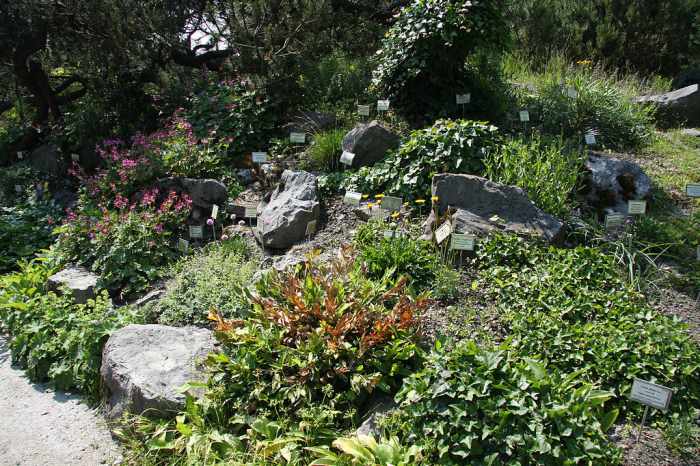Between a rock and a hard place: planning a rockery.

WHEN I was knee high to a grasshopper, the expression ”between the devil and the deep blue sea” meant you were stuck in a hopeless, no-win situation. Nowadays the American adage “between a rock and a hard place” is more likely to be used to convey the same dilemma.
But rocks are not always linked to intractable situations: gardeners for example, have always used large stones as an attractive foil for plants: their presence enables them to devise imaginative designs for spaces that might otherwise be neglected.
Christine, a reader of these columns, is planning such an enterprise. She asks: “Can you please give me some advice on plants for a rock garden ? It’s a very sunny position outside my kitchen window with a nice palm in the center. Will cactus plants be ok outside?” She adds that “the plants need to be quite small”
Christine has planted rock gardens before, but clearly creating one in a sunny tropical location means that floral staples of a temperate rock garden such as aubretia or candytuft may not thrive here in Phuket. That’s something we will return to .
For the moment let’s consider the basic principles. A rock garden is normally a raised area. So because the rockery has a vertical as well as a horizontal dimension, it can support more plants than a conventional bed.
Begin, therefore, by building a base of coarse rubble or gravel – to allow for efficient drainage. Then construct your raised bed on top, using a mix of organic-enriched loam, sand, and, if possible, some binding agent such as coir to minimize erosion. The sand is important both to assist run-off and to help plants such as cacti and succulents which need silicates in the soil to help them flourish, and whose roots will rot if they sit in water. Other alternatives to sand might include pumice (not readily available), or grit. Avoid clayey soils or woody mulches which will retain too much moisture.
The rocks are of course, key elements in the project. Some gardeners prefer a porous, striated rock such as limestone. The advantage of such a material is that all the strata can all be positioned to run the same way – exactly as they would in a natural setting – and thus give the rockery an established look. Personally I prefer an impervious stone that will not stain since it does not absorb water: my own rock garden has dark gray shale components – though granite is a proven alternative.
The rocks or “keystones”, should be inserted into the soil so that about a third is concealed and – very important – should be installed at a slight upward angle so that the visible stone is higher that the concealed part. In this way, the soil does not erode so easily during heavy rain because the water runs back into the elevated area. Again it is a matter of personal preference, but I suggest about an equal space between each stone with a good depth of earth to assist bigger plants to establish secure roots. Also ensure that there is sufficient soil on top of the rocks for smaller shrubs.
The subject of specific plants will have to wait but in answer to Christine’s specific query, cacti are indeed suitable subjects for treatment; the dwarf varieties have the inestimable advantage of coming in small neat packages, especially those which form rosettes, or which come in spiky and sculptural shapes. Indeed, we will have more to say on the subject of sedums, agaves, echinocacti, sempervivums and the whole range of bromeliads next time….aswell as more conventional candidates. Watch this space.
Tip of the Week – Shearing and Trimming.
Many gardeners confuse pruning with trimming or shearing. In general, pruning benefits the plant by helping it to grow more strongly, and should not obviously compromise its natural shape.
Trimming and shearing on the other hand, are used to create formal hedges and borders that significantly alter the shape of the shrubs that are used. Normally, the hedges created are rectangular in appearance, their symmetry a triumph of man over nature. Thai gardeners are skilled at creating these attractive patterns, using shrubs that tolerate this draconian treatment such as ixora, pigeon berry, and small-leaved, evergreen holly and privet. Topiary represents this art at its highest level.
There are two potential drawbacks: one, shearing new growth means a reduction in, or absence of flowers; two, the process will result in thick leaf growth on the outside of the shrub and may lead to die-back within the crown.
If you have a question or a garden that you would like featured you can email me at: drpaccampbell@gmail.com. Further information about this gardening series and Patrick’s other work can be accessed at:patrickaccampbell.wordpress.com
— Patrick Campbell
Latest Thailand News
Follow The Thaiger on Google News:


























